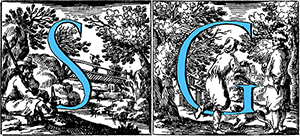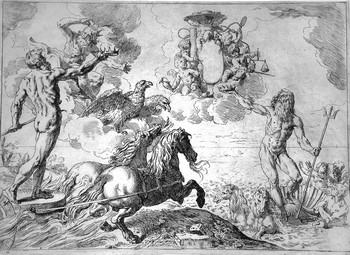
CANTARINI Simone
‘il Pesarese’ (Pesaro 1612 – Verona 1648)
Painter, engraver and draftsman born in Oropezza, near Pesaro, son of Girolamo Cantarini, a merchant and grocer from whom the late Manierist painter G. Giacomo Pandolfi aquired powder colors. This last, together with the Veronese painter Claudio Ridolfi active in Pesaro, was one of the first masters of young Simone.
In this first phase he learnt the technique from his masters, but did not adhere to their style. The models from which he took inspiration were those of the famous painter Federico Barocci, who disappeared a few years earlier. The crucial event in the artistic development of the young Cantarini was, however, the placing in the cathedral of Pesaro of a great altarpiece (now in the Vatican Gallery), of the Bolognese master Guido Reni, which aroused enormous admiration in him.
He then decided to settle in Bologna as a pupil of Guido Reni, approaching to his classical tradition. At the Reni workshop he perfected the use of etching and translated into several plates the drawings of his master. With the pass of time, feeling more confident, he became critical towards his master and his presumption led him, while Reni was absent, to correct his work in front of other students.
Many misunderstanding arose between pupil and master and also the engraving production was negatively affected. After an unpleasant episode, Cantarini abandoned the Bolognese school. Between 1639 and 1642 he worked in Marche and Rome by approaching classical and naturalistic expressive models.
After the death of Guido Reni, Simone has returned to Bologna where he was able to open his own studio, not far from the church of Santa Maria Maggiore. Rapidly this has become the seat of his own school attended by valued artists such as Lorenzo Pasinelli and Flaminio Torri and where he performed works in which the influence derived from the artistic lesson of Carracci is reflected.
During this period, noble collectors, wealthy bourgeois and simple merchants attended Simone’s studio and their requests for engravings guaranteed a continuous production of works and probably were the main source of his economic activity.
In this way Cantarini had an exceptionally abundant print production and his inventive ease is particularly evident in the vast corpus of his paintings, drawings and engravings.
Malvasia, his contemporary and friend, has told the story of the last months of Cantarini’s life.
Called in Mantua to portrait the Duke, he may have behaved badly, criticizing the paintings of the ducal collection, and retarded so much in performing the portrait that the Duke himself would have entrusted this task to other artists. This version is in contrast with the testimony of his nephew Don Girolamo Cantarini according to whom after the initial difficulties the portrait was completed with satisfaction both by the author and the Duke. Shortly after, he died in unclear circumstances at just 37 years old. According to some sources, he was perhaps poisoned by the Duke of Mantua; in contrast, other biographers have suggested the poisoning having occurred by the hands of a painter jealous of Simone’s success. After returning to Verona he died shortly after in October 1648.
In the field of engraving, he left forty etchings of own invention or derived from subjects of Guido Reni depicting the childhood of Christ, the Holy Family, figures of saints and mythological scenes. Masterpieces of graphic art executed with a light, airy and careful light value.




